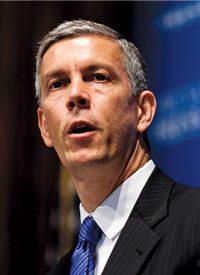
Item: An article from the Lexington Herald-Leader (Kentucky), reprinted in the Miami Herald for September 21, asserts: “Students from poor families would feel the most pain if calls by Kentucky Republican U.S. Senate candidate Rand Paul and fellow Tea Party movement conservatives to abolish the U.S. Department of Education are successful, officials and policy experts say.”
The piece goes on to say: “Doing away with the U.S. Department of Education, which administers a budget of $63.7 billion and serves 56 million students, would force officials to determine whether to downsize, reassign or eliminate an array of programs … [such as] Head Start, an early childhood education program for lower-income children.”
Item: On MSNBC for September 13, commentator Ed Schultz deplored the fact that not every child in the nation’s public schools had been compelled to watch President Obama speak on education, and vehemently objected that parents had a choice in the matter. “Treating it as a controversial event with an opt-out for right-wing wackos I think is appalling,” he said on The Ed Show. “I think the President’s speech should be mandatory for all students.”
Item: A press release from the Department of Education dated September 21 carried remarks made by Education Secretary Arne Duncan. The Secretary promised that his department would work to make American children into “good environmental citizens” through federally subsidized school programs beginning as early as kindergarten that would instruct children about climate change and prepare them “to contribute to the workforce through green jobs.”
At this point, “preparing our children to be good environmental citizens is some of the most important work any of us can do. It’s work that will serve future generations — and quite literally sustain our world.”
Correction: Never mind that all too many children in public schools can’t read, write, and figure properly, because the head educrat in Washington has more important work: He will train them to be “green.” Little wonder more people are questioning why the federal government is interfering in curricula, teacher qualification, centralized standards, and spending decisions for neighborhood schools.
The supposed rebuttal in the Kentucky newspaper noted above is extraordinarily tepid. Who knew that the federal Department of Education was such a godsend to the poor? Of course, the department doesn’t actually give away any funding that wasn’t previously ripped from the hands of those who earned it, then sent to Washington, with some of it being returned to state bureaucrats — with handling charges deducted along the way while federal mandates are added.
The Education Department didn’t even exist until Jimmy Carter created it for the National Education Association in return for its political support. The alleged catastrophe that would ensue should it be eliminated reads like an old joke. You may recall the imaginary story about various publications and how they would report a story about the impending last days, such as the left-wing paper’s headline: “World to End Today; Poor and Minorities Hardest Hit.” But the federal government isn’t joking.
Neither was MSNBC host Ed Schultz, who bitterly accused conservatives of all but whipping everyone into lockstep … at the same time that he demanded that every child in public school, the wishes of their parents notwithstanding, be coerced into listening to a political speech by Barack Obama. And should you disagree with Schultz, he resorted to the weakest ploy of all, tossing out the racial prejudice card. Schultz insisted that dissenters are “motivated by race,” charging that “there are still millions of people who just don’t want to see their kids have any association with anyone who’s black.”
Meanwhile, the federal government is not only interested in inculcating the young via one-sided environmental scare stories, it is also even more engrossed with another type of green: money. Lots of it.
The taxpayers in this country have spent, since 1965, an estimated $3 trillion on public education. During that period, the amount of spending per pupil, adjusted for inflation, has essentially tripled. Does anyone really see this as money well spent? Very few. Will more spending do the job? That’s highly unlikely.
Research by an education scholar at the Cato Institute in Washington, D.C., for example, graphically demonstrates the lack of positive correlations between federal spending, per capita, and performance (click here to see graph).
Whether the money does the job really doesn’t matter in public education. Indeed, in many cases, the worse the job, and the poorer the performance, the more money is likely to be thrown at a program. Consider the results of a study released at the beginning of the year about Head Start, which in theory is supposed to narrow the performance gap between low-income children, ages three and four, and those whose parents have more money. Put simply: It’s a failure. Having eaten up some $166 billion over 45 years, Head Start is a bust. Whatever advantage some children may gain is gone by the end of the first grade, the study indicated. And, since Washington knows best, who can question a study by the Department of Health and Human Services?
As pointed out in the New York Post in January by Andrew Coulson:
In fact, not a single one of the 114 tests administered to first graders — of academics, socio-emotional development, health care/health status and parenting practice — showed a reliable, statistically significant effect from participating in Head Start.
Some advocates of the program have acknowledged these dramatic results, but suggest that it’s not necessarily Head Start’s fault if its effects vanish during kindergarten and the first grade — perhaps our K-12 schools are to blame.
But that’s beside the point. Even if it’s true, it means that Head Start will be of no lasting value to children until we fix our elementary and secondary schools. Until then, money spent on Head Start will continue to be wasted.
Not long ago, while backing a call for more federal spending, the Education Secretary was making even more dubious claims, saying, “Districts around the country have literally been cutting for five, six, seven years in a row. And, many of them, you know, are through, you know, fat, through flesh and into bone.”
Well, not exactly. Columnist John Stossel has cited research from 14,000 school districts that shows that only seven had really cut their budget seven years running. Even if that figure about cuts were to be dropped to five years, the total was just 87 — or a fraction of one percent. No, the problem with American public schools is not a lack of spending.
One of the more insidious ways the federal government gets deeper into what should, properly, be a state and local issue, is by bribing us with our own money. Thus, when you hear — as has recently been the case — that the “states” have come up with a program for standards, you are certainly not getting the whole story.
Consider the Core State Standards Initiative, which is supposedly voluntary and led by the states. While the federal government may not have put a gun at the heads of the states, writes Neal McCluskey of the Center for Educational Freedom, it has “its hand firmly in taxpayers’ wallets.” As he put it in National Review (online):
Budgetary blackmail has enabled Washington to impose everything from No Child Left Behind to uniform speed limits: The feds tax state citizens and then tell state politicians that if they want some of the money, they must “voluntarily” obey federal rules.
Here’s how the process has worked with national standards. Tucked into the gargantuan federal “stimulus” was the “Race to the Top” fund, a $4.35 billion pool of money controlled by the U.S. secretary of education. To compete for RTTT [Race to the Top] dollars, states had first to endorse the CCSSI [Common Core State Standards Initiative], and now have to agree to adopt its standards….
Unfortunately, RTTT is likely just the start of federal strong-arming.
When there is federal money, there are bound to be federal strings attached. Or, even more likely, federal ropes. It may take a while, but the day comes when the pretense is over. Then, to mix metaphors, the federal piper will demand the tune to be played. Author Bill Costello, writing in the American Thinker, has noted that in these tough economic times, it becomes even more difficult to justify turning down millions of federal dollars. “Typically, when federal financial strings are attached, control begins with a nudge. Then it’s a push. Then it’s a shove. Ultimately, it ends up becoming a takeover. For now, it’s a nudge to national education standards. Then it will be a push to national testing. Then it will be a shove to a national curriculum.”
We also keep hearing how we must have national standards to be able to catch up with the rest of the world. A favorite complaint by the promoters of centralization is that there is a “hodgepodge” of state standards that make it difficult for proper comparisons. The advocates, of course, don’t tell you that their standards will be the one-size-fits-all variety that will likely become a triumph of mediocrity, with higher performing states being dumbed down toward the “average.”
Yet, the drive to nationalize education is based on a number of faulty or misconceived notions. The idea that imposing national standards from Washington will make Americans more competitive is not borne out by facts. Analysts Lindsey Burke and Jennifer Marshall took note of this in a Heritage Foundation “Backgrounder” in May. The relationship between the existence of national standards and superior educational outcomes “is not clear.” They continued:
While the countries that outperform the United States on international tests have national standards, so do most of those countries that score lower than the U.S. In further defiance of the hypothetical rule, Canada handily outscores the United States on international exams but has no national standards. Even the relationship between the quality of state standards in the U.S. and academic performance is weak and inconsistent across subject areas.
In actuality, of course, this is not about education. Washington is all about power. The more that states and localities can be rendered dependent on federal dollars, the more power accrues to the liberal educational establishment. It makes it much easier to direct what should be taught, to the point of transforming children into environmental stoolies in the name of “saving the world.”
— Photo of Arne Duncan: AP Image



